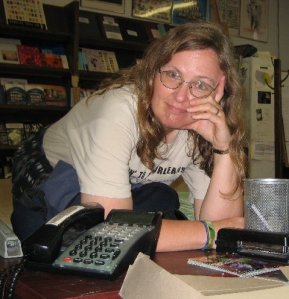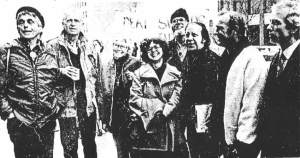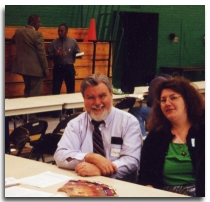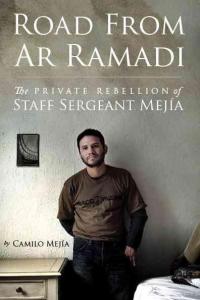It’s been forever, I know. I should have at least updated my other shop’s cheers as Sotomayor became a Justice, especially the soulful essay about how she, a wise Latina herself, felt during that confirmation ceremony. But given the demands of that other shop (go look! Make comments!) and that I’ve been writing the last two chapters of my book simultaneously, I’d made a conscious decision not to blog until I was done. Well, not completely conscious, or else I’d have put up one of those “Gone Fishin”signs.
But last week I finally went to this convention, which I’ve described to friends as “like going to a party where fully half your characters are there to answer the questions you never asked.” Veterans for Peace, founded in the wake of the collapse of the Nuclear Freeze movement, and containing many of the folks I’ve now been writing about for years.It began with a rousing statement from Rep. Donna Edwards (above), who like me isn’t a veteran, but who may as well be: her father was career military, and she remembers when her father was stationed in the Philippines and “if we wanted ice cream, we had to go all the way to Quezon City” because in military facilities, including the huge Clark Air Force Base, “all the hangars and freezers were filled” — she choked up — “with the caskets of young men and women who had died in Vietnam.” That told her, she said, “When we ask our young people to sacrifice, it’s our responsibility to get it right.”
I remember when Edwards was “just” the director of the National Network Against Domestic Violence, and we were working together on military issues: that one, like many of the issues jostling in my brain and this book, was challenge and enriched by the information streaming everywhere last week.

 Much was super-informal, with benefits: e.g. I warned Paul Cox (right), who I’ve known nearly 15 years now, that he was a star of my Vietnam chapter, and as a bonus he let me see and upload some 1969 photos he’d just got hold of. (They proved what I’d always guessed: he was even more of a babe at age 19 than now.)
Much was super-informal, with benefits: e.g. I warned Paul Cox (right), who I’ve known nearly 15 years now, that he was a star of my Vietnam chapter, and as a bonus he let me see and upload some 1969 photos he’d just got hold of. (They proved what I’d always guessed: he was even more of a babe at age 19 than now.)
 After dropping by the Women’s Caucus — where I also got to check in at the long-pervasive issue of military sexual abuse and homophobia— I got to interview Ellen Barfield (U.S. Army 1977-1981, now on the board of War Resisters League.) Barfield told me about being stationed in 1980 at Camp Humphreys, in South Korea, when her unit and many others were suddenly put on lockdown during the Kwangju Massacre.
After dropping by the Women’s Caucus — where I also got to check in at the long-pervasive issue of military sexual abuse and homophobia— I got to interview Ellen Barfield (U.S. Army 1977-1981, now on the board of War Resisters League.) Barfield told me about being stationed in 1980 at Camp Humphreys, in South Korea, when her unit and many others were suddenly put on lockdown during the Kwangju Massacre.
“ We were put on high alert; the combat troops were given orders, and up in our unit we started getting riot training.” she told me. Asked by fellow officers if women should participate, she and other women said hell yeah, we’re soldiers too — but matters never got that far. “That’s as close as I ever came to combat,” Barfield reflects now. “But – it wouldnt have been combat, it would have been killing civilians!” Already a Nation reader who’d been struck by the grinding poverty she saw in Korea, she set about upon leaving the Army to learn more about U.S. involvement in backing up Sung’s repressive government. “People are kept for so long from knowig their history,” she told me. She learned a lot from members of the then-newborn VFP such as former CIA Asia specialist aideChalmers Johnson and Brian Willson, who’d lost his legs protesting U.S. aid to repressive governments.
We were put on high alert; the combat troops were given orders, and up in our unit we started getting riot training.” she told me. Asked by fellow officers if women should participate, she and other women said hell yeah, we’re soldiers too — but matters never got that far. “That’s as close as I ever came to combat,” Barfield reflects now. “But – it wouldnt have been combat, it would have been killing civilians!” Already a Nation reader who’d been struck by the grinding poverty she saw in Korea, she set about upon leaving the Army to learn more about U.S. involvement in backing up Sung’s repressive government. “People are kept for so long from knowig their history,” she told me. She learned a lot from members of the then-newborn VFP such as former CIA Asia specialist aideChalmers Johnson and Brian Willson, who’d lost his legs protesting U.S. aid to repressive governments.
 Barfield was soon drawn in by the nuclear-freeze movement, just as Philip Berrigan and the rest of the Plowshares movement were getting arrested at nuclear plants all over the country: Barfield was soon doing the same at the PANTEX plant near her hometown of Amarillo, Texas, and has been a “soldier for peace” ever since. I learned some of the latter story from a panel on nuclear-weapons issues, where a hikabusha (survivor of Hiroshima) asked through a translator what the U.S. was doing to teach its children about nuclear weapons.
Barfield was soon drawn in by the nuclear-freeze movement, just as Philip Berrigan and the rest of the Plowshares movement were getting arrested at nuclear plants all over the country: Barfield was soon doing the same at the PANTEX plant near her hometown of Amarillo, Texas, and has been a “soldier for peace” ever since. I learned some of the latter story from a panel on nuclear-weapons issues, where a hikabusha (survivor of Hiroshima) asked through a translator what the U.S. was doing to teach its children about nuclear weapons.
At panels on The GI Rights Hotline and on active-duty resistance, I learned more about the still-ongoing cases of current resisters such as Agustin Aguayo (above), and of those in exile fighting for asylum, like Andre Shepherd (below), whose German support network includes a woman who’s been doing this work on and off since the Vietnam years.I didn’t think then — but do now as I write this – that if I had stayed at CCCO a mere year longer, I might never have felt able to leave.
Despite the friendliness of the members of Iraq Veterans Against War, though, I was perhaps too shy about the IVAW workshops, fearing they were tired of me already — something I regret and don’t, now.
 Because on my way out of town, I touched base with John Judge — who has been doing this work literally since I was two years old, including with the G.I. Project of VFP’s vibrant predecessor. John described for me what he witnessed when Vietnam Veterans Against the War was neutralized by the Red Squad in 1974, “destroy[ing] the single most visionary and effective peace group in history.” (I’d already written about these events here, drawn from documentary evidence).
Because on my way out of town, I touched base with John Judge — who has been doing this work literally since I was two years old, including with the G.I. Project of VFP’s vibrant predecessor. John described for me what he witnessed when Vietnam Veterans Against the War was neutralized by the Red Squad in 1974, “destroy[ing] the single most visionary and effective peace group in history.” (I’d already written about these events here, drawn from documentary evidence).
 When the RU moved into VVAW’s Chicago headquarters (note the North Vietnamese star at the center of the logo), so did posters and newspapers with appropriately “militant” headlines, such as: VVAW BATTLES V.A. THUGS. A civilian volunteer named John Judge, who watched the transition, was astounded. “Were they really advocating physical violence against medical personnel?”
When the RU moved into VVAW’s Chicago headquarters (note the North Vietnamese star at the center of the logo), so did posters and newspapers with appropriately “militant” headlines, such as: VVAW BATTLES V.A. THUGS. A civilian volunteer named John Judge, who watched the transition, was astounded. “Were they really advocating physical violence against medical personnel?”
The transition did, Judge added, have its comic elements: “They came in with these handlebar mustaches and sideburns, like Stalin, and these flannel workshirts.” Romo and his RU peers also told Judge to stop reading a pop history book in his bag, because We only read Marx and Engels here. “I told them, Those books are 150 years old now.” But the new regime also purged any members they deemed not “correct,” which included many who had been working triple time to help the new veterans get what they needed.
The January 1975 issue of THE VETERAN, whose “Vets Fight V.A” article was just before the “Victory to the Indochinese,” was also its last until 1996. The closer RU got to its goals, the more complete the damage to an organization once powerful enough to scare Nixon.
 That conversation with John stayed mostly comic/elegiac. We did touch on the question I’ve since been trying, separately, to sort out: if the same has already begun to happen to IVAW, perhaps under the influence of it outgoing board president Camilo Mejia, the brilliant young scion of Nicaragua’s revolution? I mention the latter fact in full respect; Mejia (with whom I share a literary agent!) grew up in the fullness of a poet’s revolution, and his father, Carlos, wrote the Sandinista National Liberation Front’s national anthem. His speech last Thursday was compelling, as when he noted that the U.S.’ unfortunate Asian land war had left room for all the democracy movements south of the border.
That conversation with John stayed mostly comic/elegiac. We did touch on the question I’ve since been trying, separately, to sort out: if the same has already begun to happen to IVAW, perhaps under the influence of it outgoing board president Camilo Mejia, the brilliant young scion of Nicaragua’s revolution? I mention the latter fact in full respect; Mejia (with whom I share a literary agent!) grew up in the fullness of a poet’s revolution, and his father, Carlos, wrote the Sandinista National Liberation Front’s national anthem. His speech last Thursday was compelling, as when he noted that the U.S.’ unfortunate Asian land war had left room for all the democracy movements south of the border.
But my concern was rooted in more than Camilo’s charisma: rumor has it that while I was worrying about ANSWER (Workers’ World Party) and World Can’t Wait (RCP) leeching off the younger group, I was too distracted by their sideshow to see the steady recruitment tactics of this group, only a few years younger than RCP and hipper/younger/jazzier in its presentation.
It’s not a meaningless question: dissenting soldiers are already being marginalized every minute. I hope those rumors are incorrect, but I’m not that optimistic.But my job now is to find out what actually happened, and to tell that story as honestly as I can.
(p.s. Thanks so much to Gerry Condon, whose comment below helped me correct some errors born of hurry and 50 percent humidity. That’s part of what this blog is for.)
